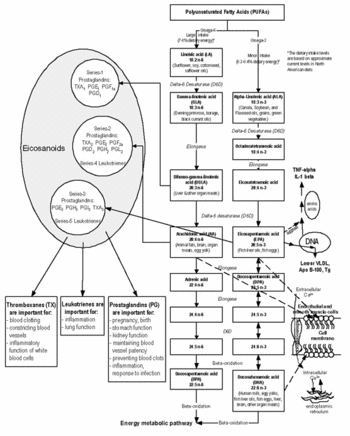Fish oil: Difference between revisions
imported>Robert Badgett |
imported>Robert Badgett |
||
| Line 15: | Line 15: | ||
| Metabolic products ||[[Eicosapentaenoic acid]] (EPA)<br/>[[Docosahexaenoic acid]] (DHA)<br/>(Fish oils contain EPA and DEA)|| [[Arachidonic acid]] | | Metabolic products ||[[Eicosapentaenoic acid]] (EPA)<br/>[[Docosahexaenoic acid]] (DHA)<br/>(Fish oils contain EPA and DEA)|| [[Arachidonic acid]] | ||
|- | |- | ||
| Physiology||style="background:lightgreen"|• suppression of [[cytokine]]s||style="background:red"|• platelet aggregation<br/>• vasoconstriction<br/>• synthesis of [[cytokine]]s | | Physiology||style="background:lightgreen"|• suppression of inflammatory [[cytokine]]s||style="background:red"|• platelet aggregation<br/>• vasoconstriction<br/>• synthesis of inflammatory [[cytokine]]s | ||
|} | |} | ||
Revision as of 12:53, 4 February 2009
Fish oils, including Omega-3 fatty acids, are dietary "oils high in unsaturated fats extracted from the bodies of fish or fish parts, especially the livers. Those from the liver are usually high in vitamin A. The oils are used as dietary supplements, in soaps and detergents, as protective coatings, and as a base for other food products such as vegetable shortenings."[1]
Classification
| ω-3 fatty acids | ω-6 fatty acids | |
|---|---|---|
| Essential precursor | α-linolenic acid (ALA) | linoleic acid (LA) |
| Proportion of North American diet | 9% | 89% |
| Dietary source | Leafy green vegetables, canola and soybean oil. | Cooking oils including safflower, sunflower, soy, and corn |
| Metabolic products | Eicosapentaenoic acid (EPA) Docosahexaenoic acid (DHA) (Fish oils contain EPA and DEA) |
Arachidonic acid |
| Physiology | • suppression of inflammatory cytokines | • platelet aggregation • vasoconstriction • synthesis of inflammatory cytokines |
Biochemistry

Polyunsaturated fatty acids (PUFAs) metabolic pathways in humans.[2]
Dietary fatty acids can be divided into saturated fatty acids and unsaturated fatty acids.[2] Unsaturated fatty acids can be further divided into monounsaturated and polyunsaturated fatty acids (PUFAs).
PUFAs are divided into two groups: omega-3 fatty acids and omega-6 fatty acids. Whereas omega-3 fatty acid have health benefits due to several mechanisms; omega-6 fatty acids are precursors to arachidonic acid (AA) which leads to thrombaxanes which promote platelet aggregation and vasoconstriction.
Two PUFAs, α-linolenic acid (ALA) and linoleic acid (LA) are called essential fatty acids because human function requires them, yet humans cannot synthesize then in vivo.[2] ALA is a omega-3 fatty acid while AL is a omega-6 fatty acid. In North America, LA comprises 89% of the total PUFAs consumed, while ALA - which leads to the favorable omega-3 fatty acid pathway - comprises only 9%.[2] LA is in many commonly used oils, including safflower, sunflower, soy, and corn oil. ALA is in leafy green vegetables and in canola and soybean oil.
Dietary fish oils are converted to eicosapentaenoic acid (EPA) which is further converted to docosahexaenoic acid (DHA). Both EPA and HHA are omega-3 fatty acids.
Benefit to human health
The benefit of fish oil on coronary heart disease and mortality is controversial with conflicting conclusions reached by a negative meta-analysis (search date February, 2002)[3][4] of randomized controlled trials by the international Cochrane Collaboration, a partially positive systematic review (search date July, 2005)[2] by the Agency for Healthcare Research and Quality (AHRQ), and a positive systematic review (search date March, 2007)[5]. The AHRQ review noted differences among types of fish oils, "Evidence suggests that increased consumption of n–3 FAs from fish or fish-oil supplements, but not of α-linolenic acid, reduces the rates of all-cause mortality, cardiac and sudden death, and possibly stroke." They note that less than 5% of α-linolenic acid is converted to to EPA or DHA.
Three subsequent randomized controlled trials not included in the above systematic reviews have also had conflicting results finding both benefit (reduction on coronary events in Japanese hypercholesterolemic patients[6] and improvement in patients with heart failure[7]) and harm[8].
- Yokoyamas[6] used "eicosapentaenoic acid...EPA was given at a dose of 600 mg, three times a day after meals (to a total of 1800 mg per day)"
- Gissi[7] used "one capsule per day of 1 g n-3 PUFA (850–882 mg eicosapentaenoic acid and docosahexaenoic acid as ethyl esters in the average ratio of 1:1·2)"
References
- ↑ Anonymous (2024), Fish oil (English). Medical Subject Headings. U.S. National Library of Medicine.
- ↑ 2.0 2.1 2.2 2.3 2.4 2.5 Wang C, Harris WS, Chung M, Lichtenstein AH, Balk EM, Kupelnick B, Jordan HS, Lau J (2006). "n-3 Fatty acids from fish or fish-oil supplements, but not alpha-linolenic acid, benefit cardiovascular disease outcomes in primary- and secondary-prevention studies: a systematic review". Am. J. Clin. Nutr. 84 (1): 5-17. PMID 16825676. [e] http://www.ncbi.nlm.nih.gov/books/bv.fcgi?rid=hstat1a.chapter.38290
- ↑ Hooper L, Thompson RL, Harrison RA, Summerbell CD, Ness AR, Moore HJ, Worthington HV, Durrington PN, Higgins JP, Capps NE, Riemersma RA, Ebrahim SB, Davey Smith G (2006). "Risks and benefits of omega 3 fats for mortality, cardiovascular disease, and cancer: systematic review". BMJ 332 (7544): 752-60. DOI:10.1136/bmj.38755.366331.2F. PMID 16565093. Research Blogging.
- ↑ Hooper L, Thompson RL, Harrison RA, et al (2004). "Omega 3 fatty acids for prevention and treatment of cardiovascular disease". Cochrane Database Syst Rev (4): CD003177. DOI:10.1002/14651858.CD003177.pub2. PMID 15495044. Research Blogging.
- ↑ León H, Shibata MC, Sivakumaran S, Dorgan M, Chatterley T, Tsuyuki RT (2008). "Effect of fish oil on arrhythmias and mortality: systematic review". BMJ 337: a2931. PMID 19106137. PMC 2612582. [e]
- ↑ 6.0 6.1 Yokoyama M, Origasa H, Matsuzaki M, et al (2007). "Effects of eicosapentaenoic acid on major coronary events in hypercholesterolaemic patients (JELIS): a randomised open-label, blinded endpoint analysis". Lancet 369 (9567): 1090–8. DOI:10.1016/S0140-6736(07)60527-3. PMID 17398308. Research Blogging.
- ↑ 7.0 7.1 Gissi-Hf Investigators (August 2008). "Effect of n-3 polyunsaturated fatty acids in patients with chronic heart failure (the GISSI-HF trial): a randomised, double-blind, placebo-controlled trial". Lancet. DOI:10.1016/S0140-6736(08)61239-8. PMID 18757090. Research Blogging.
- ↑ Raitt MH, Connor WE, Morris C, et al (2005). "Fish oil supplementation and risk of ventricular tachycardia and ventricular fibrillation in patients with implantable defibrillators: a randomized controlled trial". JAMA 293 (23): 2884–91. DOI:10.1001/jama.293.23.2884. PMID 15956633. Research Blogging.